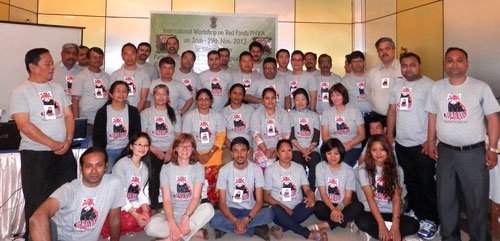|
ZOO/WILD's
2013 Activities . . .
PHVA
workshop for the Red Panda (Ailurus
fulgens), 26-29 Nov 2013 at
Siliguri, West Bengal

Red
Panda PHVA workshop participants
A
Population and Habitat Viability
Assessment (PHVA) Workshop for the Red
Panda (Ailurus fulgens) in India
was held from 26-29 November 2013 at
Siliguri, West Bengal. This PHVA
incorporated elements of the IUCN
Species Conservation Strategy approach
into the workshop process developed by
the Conservation Breeding Specialist
Group (CBSG). The workshop was organized
by Rotterdam Zoo of The Netherlands, the
Central Zoo Authority, and Zoo Outreach
Organization of Coimbatore, India. It
was hosted by Darjeeling Zoo, West
Bengal. The PHVA was facilitated by a
joint team of CBSG South Asia (Dr.
Sanjay Molur) and CBSG Europe (Dr.
Kristin Leus). Funding was provided by
the Central Zoo Authority, the Rotterdam
Zoo Conservation Fund and WWF Germany.
Workshop participants included
representatives of three range countries
– India, Nepal and Bhutan as well as
from Europe. The vision expressed by the
participants was to “Secure, viable
populations of Red Panda thriving in
contiguous natural habitats across the
eastern Himalayan sacred landscape; a
valued flagship species for the region
living in harmony with and benefitting
the people”.
In India, Red Panda's are found in
Darjeeling, Sikkim and Arunachal
Pradesh. The aim of the workshop was to
identify habitats, distribution ranges,
degree of fragmentation and threats to
Red Panda's in India and the border
areas of Nepal and Bhutan and to develop
a strategy to conserve them in natural
habitats in these areas. The
participants utilized information on
habitat characteristics, identified and
ranked threats, used simulation models
conducted in an earlier Red Panda PHVA
in Nepal in 2010, and reviewed methods
and strategies for Red Panda
conservation.
The report is being finalized and a team
of editors from the range states will be
finalizing the results within the next
three months. The results of the Red
Panda PHVA is expected to form the
action plan for conservation action on
the ground involving predominantly in
situ conservation strategies and
employing, where necessary and
appropriate, ex situ expertise
and strategies.
ZOO's PRINT Jan 2014.
|